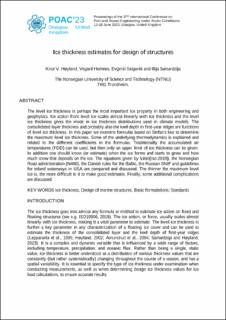Ice thickness estimates for design of structures
Peer reviewed, Journal article
Published version
Permanent lenke
https://hdl.handle.net/11250/3120158Utgivelsesdato
2023Metadata
Vis full innførselSamlinger
Sammendrag
The level ice thickness is perhaps the most important ice property in both engineering and geophysics. Ice action from level ice scales almost linearly with ice thickness and the level ice thickness gives the mode in ice thickness distributions used in climate models. The consolidated layer thickness and probably also the keel depth in first-year ridges are functions of level ice thickness. In this paper we examine formulas based on Stefan's law to determine the maximum level ice thickness. Some of the underlying thermodynamics is explained and related to the different coefficients in the formulas. Traditionally the accumulated air temperatures (FDD) can be used, but then only an upper limit of ice thickness can be given. In addition one should know (or estimate) when the ice forms and starts to grow and how much snow that deposits on the ice. The equations given by \citet{iso:2019}, the Norwegian Road administration (N400), the Danish rules for the Baltic, the Russian SNIP and guidelines for inland waterways in USA are compared and discussed. The thinner the maximum level ice is, the more difficult is it to make good estimates. Finally, some additional complications are discussed.
